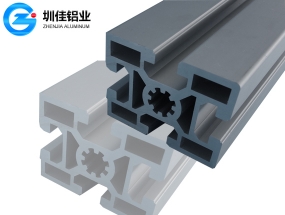In order to fully carry out the phase transformation process, the organization is fully transformed into a state at the quenching temperature, and the solid solution having the maximum degree of supersaturation after quenching must be maintained at the quenching temperature for a certain period of time.
Factors affecting the quenching time of aluminum profiles:
 (1) Heating temperature. The higher the temperature, the higher the phase change speed and the shorter the holding time. Such as 2A12 alloy at 500 °C for 10min, you can make the strengthening phase dissolved, after natural aging, the strength can reach 450MPa; if the heating temperature is 480 °C, need to heat for 15min, and the natural aging after its strength is 420MPa, than 500 Quenched at °C, 30MPa lower after aging.
(1) Heating temperature. The higher the temperature, the higher the phase change speed and the shorter the holding time. Such as 2A12 alloy at 500 °C for 10min, you can make the strengthening phase dissolved, after natural aging, the strength can reach 450MPa; if the heating temperature is 480 °C, need to heat for 15min, and the natural aging after its strength is 420MPa, than 500 Quenched at °C, 30MPa lower after aging.
(2) Pre-treatment of industrial aluminum profiles and the original microstructure (including the size and distribution of the strengthening phase). Usually the second phase of the as-cast alloy is relatively coarse, and its dissolution process is very slow. The required holding time is much longer than that of the deformed aluminum alloy profile. For the same deformed alloy, the time required for the large deformation degree is short; for the aluminum material in the annealed state, the size of the strengthening phase is larger than that of the alloy after quenching and aging, and the former needs much longer holding time than the latter.
(3) Size of industrial aluminum profiles. Under the same heating conditions and the same loading capacity, the size of the industrial aluminum profile is much longer than that of the profile. After the small-size aluminum material is heated to the quenching temperature, keeping the temperature inside and outside for a few minutes or tens of minutes can make the internal and external temperatures tend to be consistent and reach equilibrium; while the large-size industrial aluminum profiles, when the surface temperature reaches the quenching temperature, the center temperature is still far lower. At the temperature required for quenching, a temperature gradient is created in the profile. After the temperature gradient disappears, the internal and external temperatures tend to balance. Obviously, the larger the industrial aluminum profile products, the longer the time for inward heat transfer to reach equilibrium, and the correspondingly longer soaking time. Profiles with a wall thickness or diameter of less than 3 mm need only be kept warm for 30 minutes, but profiles with a wall thickness or diameter greater than 100 mm need to be insulated for 210 minutes.


 (1) Heating temperature. The higher the temperature, the higher the phase change speed and the shorter the holding time. Such as 2A12 alloy at 500 °C for 10min, you can make the strengthening phase dissolved, after natural aging, the strength can reach 450MPa; if the heating temperature is 480 °C, need to heat for 15min, and the natural aging after its strength is 420MPa, than 500 Quenched at °C, 30MPa lower after aging.
(1) Heating temperature. The higher the temperature, the higher the phase change speed and the shorter the holding time. Such as 2A12 alloy at 500 °C for 10min, you can make the strengthening phase dissolved, after natural aging, the strength can reach 450MPa; if the heating temperature is 480 °C, need to heat for 15min, and the natural aging after its strength is 420MPa, than 500 Quenched at °C, 30MPa lower after aging.